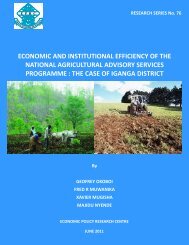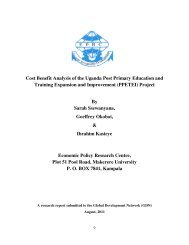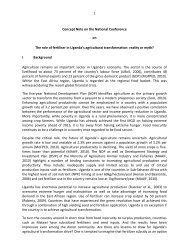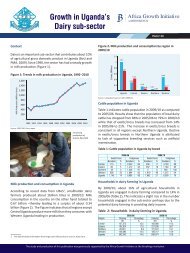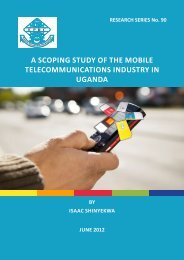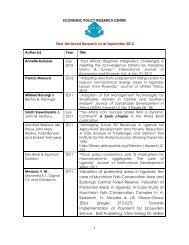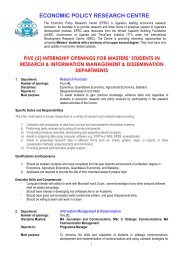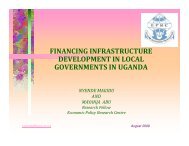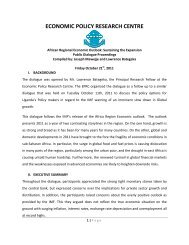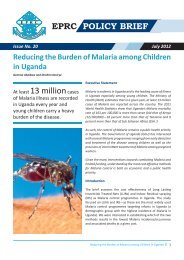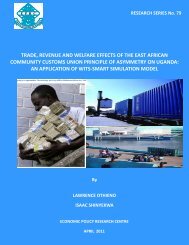The Political Context of Financing Infrastructure Development in ...
The Political Context of Financing Infrastructure Development in ...
The Political Context of Financing Infrastructure Development in ...
Create successful ePaper yourself
Turn your PDF publications into a flip-book with our unique Google optimized e-Paper software.
<strong>The</strong> <strong>Political</strong> <strong>Context</strong> <strong>of</strong> <strong>F<strong>in</strong>anc<strong>in</strong>g</strong> <strong>Infrastructure</strong> <strong>Development</strong> <strong>in</strong> Local Government<br />
to be the ma<strong>in</strong> source <strong>of</strong> revenue for local governments was abolished <strong>in</strong> 2005.<br />
In regard to <strong>in</strong>novations <strong>in</strong> rais<strong>in</strong>g local revenue, a lesson can be learnt from the local<br />
government system <strong>of</strong> Poland. Swianiewicz (2006: 312-323) shows how local governments<br />
raise revenue through taxation. He notes that the tax revenues <strong>of</strong> the local governments<br />
particularly the municipal tier <strong>of</strong> levy and raise local tax revenues from property tax, tax on<br />
agriculture, tax on vehicles, forest tax, tax on dog owners, tax on civil legal activities, tax on<br />
legacies and donations, and tax on small bus<strong>in</strong>esses. Swianiewicz (2006: 312) notes that the<br />
general rule is that the maximum rates <strong>of</strong> local taxes are decided <strong>in</strong> the central legislation,<br />
although local governments may set their own rates that are equal to or lower than the ceil<strong>in</strong>g<br />
level. He further po<strong>in</strong>ts out that local governments can also use other <strong>in</strong>struments <strong>of</strong> their<br />
own tax mechanisms. <strong>The</strong>se are <strong>in</strong>deed not only liberal provision to enable local governments<br />
to mobilise own revenue but also <strong>in</strong>novative ideas.<br />
In this paper, focus is put on three issues where Uganda can derive lessons from Poland. <strong>The</strong>se<br />
are tax on agriculture, centrally determ<strong>in</strong>ed tax ceil<strong>in</strong>gs, and local taxation <strong>in</strong>struments. On<br />
the issue <strong>of</strong> tax on agriculture, it is important to note that Uganda is a country whose economy<br />
is largely based on agriculture and if local governments were rais<strong>in</strong>g revenue from agriculture,<br />
they would have more fiscal control and flexibility <strong>in</strong> their areas <strong>of</strong> jurisdiction. Swianiewicz<br />
(2006:313) notes that tax on agriculture is the second most important local tax. He <strong>in</strong>dicates<br />
that while the basic rate is centrally def<strong>in</strong>ed, the local council may reduce the rate. This tax<br />
is typically paid by the owner <strong>of</strong> the farm or by the farmer who rents the farm. Accord<strong>in</strong>g<br />
to this author, <strong>in</strong> Poland a farm is def<strong>in</strong>ed as an area larger than one hectare that it used as<br />
arable land, that conta<strong>in</strong>s a pond, or that conta<strong>in</strong>s a build<strong>in</strong>g used for farm<strong>in</strong>g activity. He<br />
further po<strong>in</strong>ts out that, accord<strong>in</strong>g to tax regulations, it does not matter whether the area is<br />
actually cultivated or not. <strong>The</strong>refore even redundant arable land is still taxed. In Uganda, the<br />
arable land is 40 million acres (State <strong>of</strong> the Nation Address by President Museveni on June 7 th ,<br />
2012), if the Polish system was used and this land is taxed, local governments would raise a<br />
substantial amount <strong>of</strong> revenue. This is however, impeded by about three major factors; one<br />
is that this arable land is mostly occupied by peasants who do not cultivate for commercial<br />
purposes but largely for subsistence. In some cases, they even fail to produce enough to<br />
subsist on and this partly results <strong>in</strong> persistent food scarcity <strong>in</strong> different parts <strong>of</strong> the country. It<br />
is thus difficult to tax such peasants.<br />
Second, the big companies engaged <strong>in</strong> commercial production such as sugarcane and tea<br />
estates/farms are taxed by the central government. Even then, it is not tax on agriculture<br />
but on what they produce. In essence therefore, these commercial farmers do not have any<br />
tax obligations to the local governments where they are located. While this agriculture tax<br />
would be a good <strong>in</strong>novation for local governments, there would still be need for the central<br />
12<br />
Economic Policy Research Centre - EPRC




